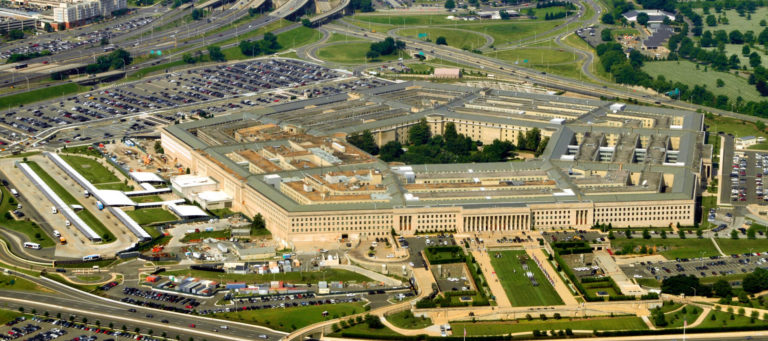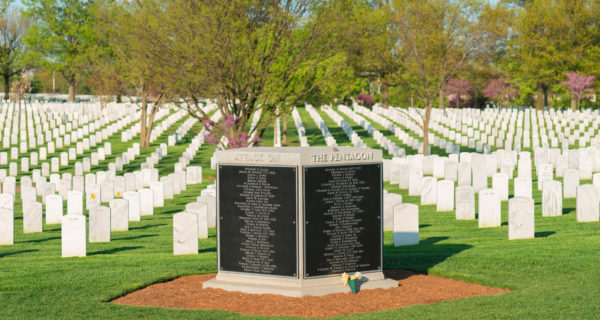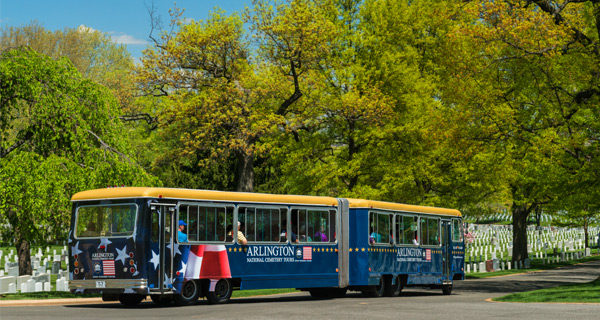-
One of the largest office buildings in the world, the Pentagon serves as the headquarters of the United States Department of Defense. A symbol of American military strength, the concrete and steel building is recognized around the world. Nearly 30,000 military and civilian personnel work inside the Pentagon each day. Covering approximately 6.5 million square feet, the building contains a food court and mini-shopping mall. Because of its size, the Pentagon has six ZIP codes. It uses the place identifier for Washington, DC even though the five-sided building is actually located in Arlington, Virginia.
-
The Building
The famous edifice has five rings, five floors above ground and two floors below ground. There are almost 18 miles of corridors. Despite its size, the layout of the hallways and interconnecting walkways enables an individual to reach any office in less than seven minutes. The rings are labeled “A” through “E” from the interior courtyard to the outside. Because the E-ring is the only one with exterior views, it is the location for offices of the most senior officials. The five-acre courtyard park is nicknamed Ground Zero. The term was inspired by the belief that the park would be a primary target for Soviet nuclear missiles during the Cold War. The Pentagon is twice the size of the Merchandise Mart in Chicago. The U.S. Capitol would fit in just one of the building’s five wings.
The Northern Mall Terrace façade features a portico that leads to a 600-foot-long terrace that is used for various official ceremonies. The portico of the River Entrance façade overlooks a lagoon and a landing point. The dock was once used by duty boats that transported service members across the Potomac River to Bolling Air Force Base. The main visitor entrance, the Concourse Entrance façade, is the location of the Pentagon Metro stop. The other two facades are known as the Helipad and South Parking entrances. The site of numerous anti-war protests over the years, the Pentagon was added to the National Register of Historic Places in 1989.
-
History of the Pentagon
During World War I, the War Department was housed in a variety of permanent and temporary buildings in and around Washington, DC. In the late 1930s, a new headquarters was constructed in the Foggy Bottom neighborhood. This building soon proved inadequate. It is currently used by the State Department. With the rapid expansion of the War Department during World War II, Secretary of War Henry Stimson lobbied President Franklin Roosevelt for a large permanent office building. In 1941, it was agreed that a new large office building would be constructed in Arlington. The original site selected for construction was the pentagon-shaped Arlington Farms, a temporary housing complex for female civil servants operated by the Department of Agriculture.
When concerns arose that the new building might obstruct views of Washington, DC from Arlington National Cemetery, the construction site was moved to the former Hoover Field Airport. To keep costs down, the building’s pentagon-shape design plans were retained. The configuration was reminiscent of the star-shaped forts built during the gunpowder age. To reduce the amount of steel used, architects incorporated ramps rather than elevators in the building. Steel was in short supply and needed for the war effort. The exterior façade is adorned with Indiana limestone. Architectural, design and construction work were accomplished simultaneously, and the building was constructed in sections to save time. Colonel Leslie Groves who later oversaw the Manhattan Project as a general officer, supervised the work on the Pentagon. The building cost slightly more than $31.1 million to complete in 1943.
During construction, segregation laws in Virginia required separate rest room facilities for blacks and whites. As a result, the Pentagon has a higher ratio of rest rooms for its occupants than most similar size office buildings. It was the only public building in Arlington with segregated rest rooms until 1965. On Sept. 11, 2001, American Airlines Flight 77 struck the western side of the Pentagon killing 189 people. Although approximately one-third of the building was damaged, the repairs were completed by the anniversary of the attack. The repairs were incorporated into a larger ongoing renovation program that was completed in 2011, which brought the Pentagon up to standards required for modern office buildings.
-
Must See Exhibits
More than 100,000 people visit the Pentagon each year. A 60-minute guided tour highlights the history of the building and the Department of Defense. Covering approximately 1.5 miles, the guided tour includes the Hall of Heroes, which honors America’s Medal of Honor recipients, as well as an exhibit dedicated to prisoners of war and those missing in action. You will also see numerous portraits of the country’s founding fathers and a painting depicting the signing of the Declaration of Independence.
While at the Pentagon, guests can also see the National 9-11 Pentagon Memorial. Situated on the west side of the building, the memorial is dedicated to those who lost their lives that fateful day. The 2-acre park features illuminated benches engraved with the names of the victims, memorial pools and a wall ranging from 3 inches to 71 inches in height to represent the ages of the youngest and oldest victims. There are also 85 paperbark maple trees. Open seven days a week, it is the only place on the Pentagon grounds where photography is permitted.
There is also a burial marker in nearby Arlington National Cemetery. It marks the grave of the 184 victims of the attack on the Pentagon. Located in Section 64, the five-sided granite marker lists the names of those who perished on the plane and inside the Pentagon.
The Pentagon parking lots are used as the staging point for a number of annual events. These include Rolling Thunder, a gathering of motorcycle enthusiasts showing support for America’s prisoners of war and missing in action, the Army Ten-Miler and the Marine Corps Marathon.
-
Know Before You Go
You must make reservations for the guided tour at least 14 but not more than 90 days in advance. Tours are offered Monday through Friday from 9 a.m. until 3 p.m. except on federal holidays. Visitors 18 and older require a valid government-issued photo ID. The tour starts at the visitor center just to the left, inside the Pentagon Metro entrance. Arrive at least an hour before your scheduled tour to pass through security. The Metro stop is on the Blue and Yellow lines. The Pentagon does not have public parking.
-
Nearby Attractions
Arlington National Cemetery is the location for the Tomb of the Unknowns and the gravesite of President John F. Kennedy along with numerous other monuments and memorials. It is also the burial ground for many famous Americans and war heroes, including Audie Murphy, Abner Doubleday and Joe Louis. There are monuments and memorials to the space shuttles Challenger and Columbia as well as Women in the Military Service, Pan Am Flight 103 and Spanish American War Nurses.
Formerly known as Columbia Island, Lady Bird Johnson Park includes scenic walking and driving paths, colorful plantings and blooming trees that provide vivid Spring and Fall foliage. There are overlooks and picnic areas as well. The park also features the Lyndon Baines Johnson Memorial Grove and the Navy and Marine Memorial. The Mount Vernon Trail passes through the park.




